The Cactaceae III, 156, 1922
Basionym: Echinocactus hyptiacanthus Lemaire, Cact. Gen. Nov. Spec. 21, 1839
Tělo protáhlé, s velmi proláklým temenem, sytě zelené. Žebra 11, hrbolcovitá, rýhy proříznuté, bradavky skoro šestiboké, areoly oválné. Trnů 7, nerovnoměrně dlouhých, krátkých a tenkých, poněkud tuhých, k tělu zahnutých, zlatožlutých, 4 z nich jsou v páru, směřují do stran. Hrbolce jsou uspořádány do 11 svislých řad, které jsou na bázi přibližně šestihranné, spojené mezi sebou příčnou rýhou, na základně 4 – 5 linky široké. Podélné brázdy jsou zvlněné, později mělké, s dolů sbíhající zelenější linkou. Areoly vejčité, s vločkami, bílé, s dlouho setrvávající plstí, která je později popelavě šedá. Trny 6 – 7, z nichž 1 – 2 na horním konci svazků trnů jsou vlasovité, 1 – 2 linky dlouhé, 4 boční jsou v párech, z nichž dva nejspodnější jsou poněkud silnější, 3 – 4 linky dlouhé. Nejspodnější trn 4 – 5 linek dlouhý. Všechny trny tenké ale dost pevné, k tělu ohnuté, zlaté barvy, na základně a u špice purpurově červené.
Velmi pěkný a vynikající druh, příbuzný Etus gibbosus, avšak zcela odlišný. Popisovaná rostlina 2,5 coulu vysoká a má 2 couly v průměru, avšak zdá se, že je již dospělá.
Hyptiacanthus původem z řečtiny znamená s pokroucenými trny.
Lemaire tento taxon pozoroval v Monvilleho sbírce, jedinec měl tehdy 5 cm v průměru a 6,5 cm byl vysoký. Roku 1845 zmiňuje tento taxon Förster a uvádí též popis, téměř shodný s původním popisem a uvádí, že taxon byl znovu importován roku 1840, tedy rok po popisu.
Roku 1853 zmiňuje Labouret tři variety – var. eleutheracanthus, megalothelos a nitidus, které však mimo dosud tajemné Gymn. megalothelos jsou již takřka nedefinovatelné. Schumann ve svém díle Gesamtbeschreibung popis poněkud pozměnil a považuje Etus. hyptiacanthus za synonym Etus. leeanus Hook. To tedy bylo více jak 45 let po popisu, kde není ani zmínka o květu; v původním popisu je velice zavádějící informace „příbuzný Etus. gibbosus“ – uvažme jen, kolik taxonů dnešního rodu Gymnocalycium znali kaktusáři roku 1839 a kolik tedy měli tehdy možností k příbuzenskému zařazení. Schumann uvádí jako barvu květu žlutavě bílou, avšak kde byl v té době konec původně popsaného taxonu. Jak přišel o údaji výskytu Uruguay, dnes již nezjistíme.
Původnímu popisu Lemaireho podobné rostliny přivezl A.V. Frič z Uruguaye a označil je jako Gymn. hyptiacanthum var. citriflorum nom. nud. Hugo Schlosser našel v Uruguayi také takové rostliny, odpovídající popisu, a dodává, že rostliny jsou na stanovištích co do otrnění velmi variabilní. I v kultuře můžeme z výsevů různých polních značek z poslední doby nalézt takto otrněné formy se zářivě žlutými trny, jejichž barva nějaký zlatý odstín může připomínat. Dr.Schütz ve své Monografii 1986 správně uvádí, že k tomuto taxonu budou patřit i následující jména: Gymn. netrelianum (popsané jako Echinocactus netrelianus 1855, tedy o 16 let později), Gymn. leeanum (popsané jako Echinocactus leeanus 1845, tedy o 9 let později), jakož i Fričovo Gymn. hyptiacanthum var. citriflorum, Gymn. leeanum var. brevispinum Backbg. et Knuth a Gymn. guerkeanum (popsané jako Echinocactus guerkeanus 1911). Všechny tyto formy variabilního okruhu budou snad udržitelné jen jako formy či variety.
V rakouském časopisu Gymnocalycium 2001 byly publikovány nové kombinace a pokusy o přeřazení tohoto a jiných taxonů z tohoto podrodu do podrodu Gymnocalycium (Ovatisemineum): Gymn. hyptiacanthum (prý = Gymn. schroederianum ssp. bayense), nebo Gymn. reductum ssp. leeanum. Podle Nomenklatorických pravidel ICBN (Art 9.8) viz Kiesling, Marchesi a Ferrari KuaS 2002 však není možné přeřazovat taxony z jednoho podrodu do druhého – jistě správné opatření. Autoři současně uvádějí stanovení neotypu Gymn. hyptiacanthum patřícího do podrodu Gymnocalycium Uruguay, department Florida, Cerro Pelado, 17.6.1990 Kiesling + Kroenlein 8505 (SI)
Ve sbírkách tyto rostliny velmi brzy kvetou společně s Gymn. bruchii, jako první gymnokalycia. Mají rády vlhko po celé vegetační období, a v substrátu přídavek rašeliny. Nejlépe se jim daří v pařeništi mírně stíněné, ve skleníku pak se stálým přísunem vody. V období letních veder dochází ke stagnaci jen tehdy, když je k tomu pěstitel svými přehmaty donutí – tak jako jiné druhy rodu. Taktéž jako jiné kaktusy mají rády teplo; v nevětraném skleníku se jim daří i na vrchnějším parapetu a znamenitě prospívají i při 50°C – ale musí stát ve vodě.
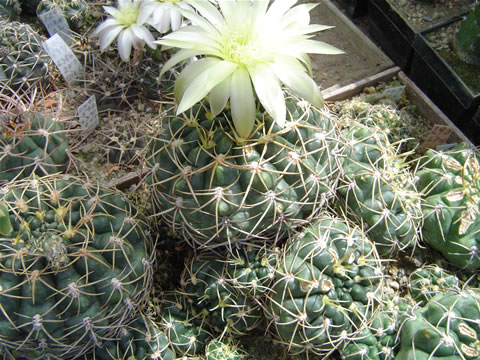
Gymn. hyptiacanthum
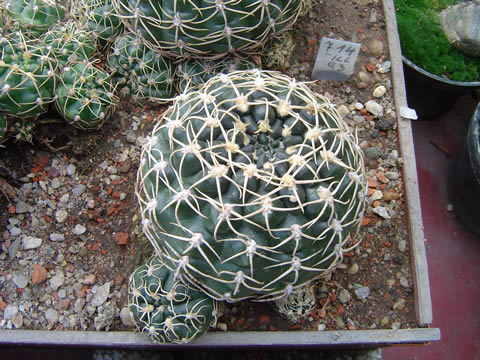
Gymn. hyptiacanthum
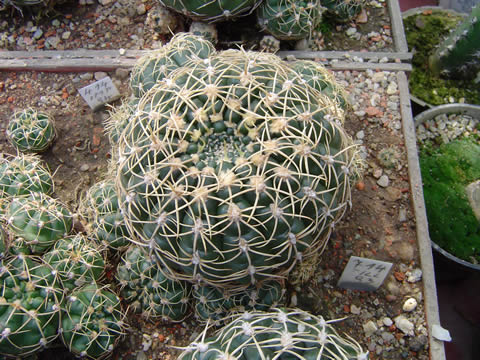
Gymn. hyptiacanthum
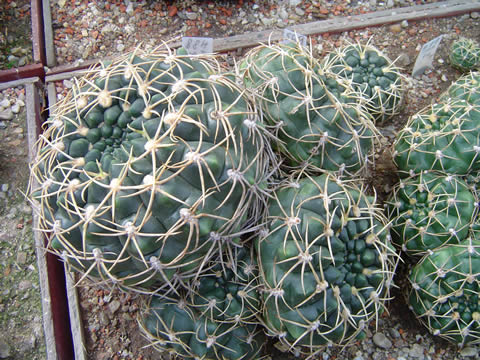
Gymn. hyptiacanthum
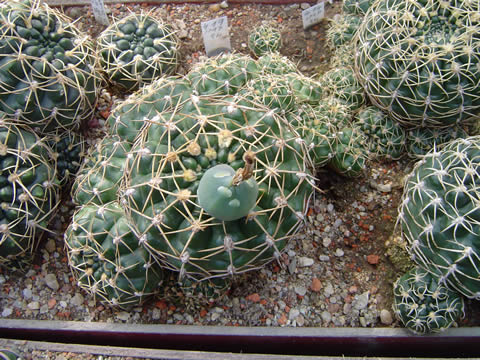
skupina Gymn. hyptiacanthum
Gymn. hyptiacanthum – summary:
From the original description: „Very nice and excelent sort, related to Etus. gibbosus, but quite different. The desribed plant 2,5 inches high and 2 inches across, however, it seems to be already mature“.
Lemaire had observed this taxon in the collection of Monville, the specimen had 5 cm in diameter at that time and was 6,5 cm high. Förster mentioned this taxon in 1845 and published also the description nearly agreeing with the original description and mentioned that the taxon was once more imported in 1840, then one year after the description. Labouret mentioned in 1853 three varieties – var. eleutheracanthus, var. megalothelos and var. nitidus, however, which – with the for the time being mysterious Gymn. megalothelos – are nearly not able to determine yet. Schumann in his work Gesamtbeschreibung had rather changed the description and he had held Etus. hyptiacanthus for the synonym of Etus. leeanus Hook. Then it has been more than 45 years after the original description, where no data about a flower had been; there is very mysterious information in the original description „related to Etus. gibbosus“ – we must only remember, how many taxa of now known genus Gymnocalycium were known to cactophiles in 1839 and so how many possibilities they had to the affinity rowing at that time. Schumann mentioned like the colour of the flower yellowish white, however, where had been the end of the originally described taxon at that time. We will not find like he had come to the data about the occurence in Uruguay.
Alberto Vojtěch Frič had brought from Uruguay the plants similar to the original description of Lemeire and he had marked them like Gymn. hyptiacanthum var. citriflorum nom. nud. Hugo Schlosser had also found the plant like this in Uruguay agreeing with the description, and he had mentioned in the addition that the plants are very variable as to the spination on the finding places. We can also see in the collections the plants spined like this, in seedlings sowed from the seeds of the various field numbers, the forms with shiny yellow spines, whose colour can imagine some gold touch. Dr. Schütz mentioned very right in his Monography of 1986, that they belong to this taxon even the following names: Gymn. netrelianum (described like Etus. netrelianus 1855, then 16 years later), Gymn. leeanum (described like Etus. leeanus 1845, then 9 years later), also Frič´s Gymn. hyptiacanthum var. citriflorum, Gymn. leeanum var. brevispinum Backbg. et Knuth and Gymn. guerkeanum (described like Etus. guerkeanus in 1911). All these forms of the variable relationship will be maybe able to keep only like forms or varieties.
There were published in the Austrian Gymnocalycium 2001 new combinations and the attempts at the overrowing of this and the other taxa from this subgenus into the subgenus Gymnocalycium (Ovatisemineum): Gymn. hyptiacanthum (it was said = Gymn. schroederianum ssp. bayense), or Gymn. reductum ssp. leeanum. However, it is not possible to overrow taxa from one subgenus to the another one after the Nomenclatory rules ICBN (Art 9.8) – see Kiesling, Marchesi and Ferrari KuaS 2002 – very right precaution, of course. The authors stated also neotyp of Gymn. hyptiacanthum belonging to the subgenus Gymnocalycium Uruguay, department Florida, Cerro Pelado 17.6.1990 Kiesling and Kroenlein 8505 (SI).
The plants flower very soon in the collections with Gymn. bruchii as the first gymnocalyciums. They love moisture during the whole vegetative season and some addition of peat in the soil. They grow the best in hotbeds, slightly shadowed, or in greenhouse with still water feed.
There is a stagnation during the summer warm days only in the case if the grower has forced them with his misfeahances – like at the other sorts of the genus. They like warm also like the other cacti; they profit very well even in the superior shelf in the greenhouse without a ventilation even at the temperature of +50°C – however, they must stay in water.
